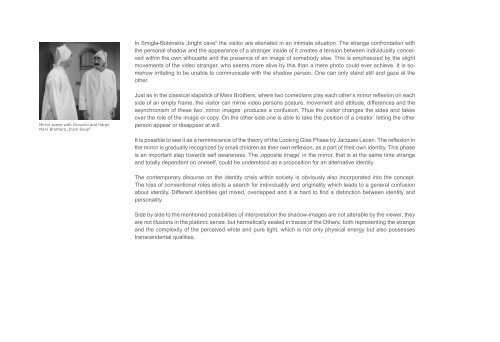Karina Smigla-Bobinski
Karina Smigla-Bobinski
Karina Smigla-Bobinski
You also want an ePaper? Increase the reach of your titles
YUMPU automatically turns print PDFs into web optimized ePapers that Google loves.
In <strong>Smigla</strong>-<strong>Bobinski</strong>s „bright cave“ the visitor are alienated in an intimate situation. The strange confrontation with<br />
the personal shadow and the appearance of a stranger inside of it creates a tension between individuality conceived<br />
within the own silhouette and the presence of an image of somebody else. This is emphasized by the slight<br />
movements of the video stranger, who seems more alive by this than a mere photo could ever achieve. It is somehow<br />
irritating to be unable to communicate with the shadow person. One can only stand still and gaze at the<br />
other.<br />
Mirror scene with Groucho and Harpo<br />
Marx Brothers „Duck Soup“<br />
Just as in the classical slapstick of Marx Brothers, where two comedians play each other‘s mirror reflexion on each<br />
side of an empty frame, the visitor can mime video persons posture, movement and attitude, differences and the<br />
asynchronism of these two ‚mirror images‘ produces a confusion. Thus the visitor changes the sides and takes<br />
over the role of the image or copy. On the other side one is able to take the position of a creator: letting the other<br />
person appear or disappear at will.<br />
It is possible to see it as a reminiscence of the theory of the Looking Glas Phase by Jacques Lacan. The reflexion in<br />
the mirror is gradually recognized by small children as their own reflexion, as a part of their own identity. This phase<br />
is an important step towards self awareness. The ‚opposite image‘ in the mirror, that is at the same time strange<br />
and totally dependent on oneself, could be understood as a proposition for an alternative identity.<br />
The contemporary disourse on the identity crisis within society is obviously also incorporated into the concept.<br />
The loss of conventional roles elicits a search for individuality and originality which leads to a general confusion<br />
about identity. Different Identities get mixed, overlapped and it is hard to find a distinction between identity and<br />
personality.<br />
Side by side to the mentioned possibilities of interpretation the shadow-images are not alterable by the viewer, they<br />
are not illusions in the platonic sense, but hermetically sealed in traces of the Others, both representing the strange<br />
and the complexity of the perceived white and pure light, which is not only physical energy but also possesses<br />
transcendental qualities.


